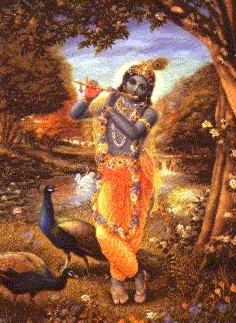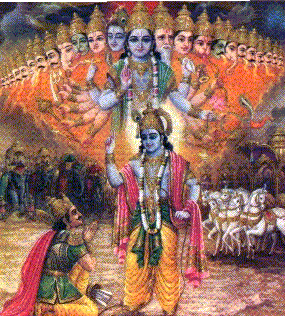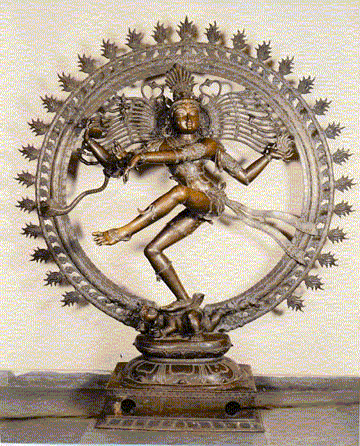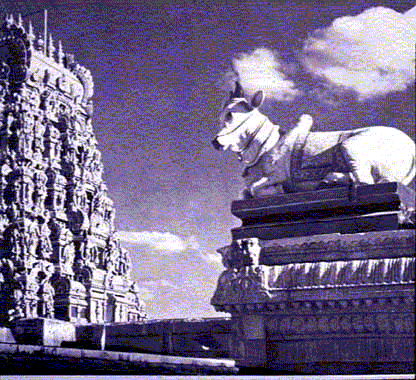by Amber Sukumaran

whatever form of worship they choose to fulfill their desires, ultimately their worship comes back to the same source." |
Table of Contents
Hinduism is a very complex belief system. It is more than a religion--it is a way of life. Much confusion in the West lies in the fact that core Hindu beliefs are often undermined by social pressures and outside influences. After moving in a direction away from the core beliefs, because of foreign influences, there is a worldwide movement among Hindus to return to the basics of their way of life.
Hinduism has no one founder, no known origin, and no one holy text. It has been established by a living culture over thousands of years.
The purpose of this essay is to introduce some main concepts and explain them in simple terms. It is also to dispel some common misconceptions.
Hinduism's steadfastness in its core principles and its ability to adapt to modern changes have allowed it to last for many thousands of years. For that reason, there are many personal interpretations of specifics, but the core beliefs remain unchanged.
The concepts explained below pervade all sects of Hinduism:
Cause no harm to other living beings either by action, word, or thought. This is why Hindus are traditionally vegetarian. By eating meat, a person takes the life of another living creature. Hindus believe that all creatures contain the life of God, the divine. By causing harm to another creature, a person causes harm to God's soul. Since all living creatures are part of God, by harming another living creature, you are ultimately harming yourself.

Ahimsa also means not speaking vulgar words or shouting insults or curses at another living creature, even an animal. It means not thinking negative things about another person or being jealous of them. Even these less-obvious forms of violence can harm a person's soul and well-being.
In recent times, many Hindu leaders have spoken against physically disciplining a child, as spanking goes directly against the principle of ahimsa, especially in the classroom. It causes fright and sadness and can lead to anger. It also forces the child's emotions to reside in the lower chakras, which can cause it harm. In any case, the child is so overcome by emotions that he or she cannot think about the actions leading up to the spanking.
Here is a classic South Indian story that illustrates both karma and ahimsa:
The universal law that what you put out into the world, either bad or good, comes back to you. It also is a way to describe the experiences that one has that helps to balance the person's soul. For example, if a person loses a leg in an accident, it could mean that he caused someone to lose a leg in the last life, or it could mean that he is need of learning compassion for the handicapped in order to further the development of the soul. Religious services, prayers, and acts of devotion soften karmas. They helps to reduce the intensity of the karma. Instead of losing a leg, the person might just break it, or stub his toe, for example. They also help a person to realize why they are experiencing things ("Perhaps I need to learn compassion for the handicapped"). When a Hindu realizes why the experience is happening and uses the experience to make him or her a better person, that karma is resolved and the person is freed from it. The end result of karma is that a soul gains a variety of experiences and wisdom over a series of lives, and eventually sees the world as God does. This is what we call a Satguru--one who is so advanced, compassionate, and loving towards all that he or she has a soul that has completely merged with God, like a drop of water going into the ocean. Karma can also be good and positive, and rewards in this life are considered the result of gains made in the last. All people strive to merge with God, but can only do it when all karmas have been cleared and no new ones created--and when understanding of God and the meaning of life occurs.
God is seen as a universal spirit with many forms. Each form represents a specific aspect of God. All forms are highly symbolic. Saraswati, for example, represents the arts and learning. Nataraja represents the cycle of life, death, and rebirth, as well as the intricasies of karma. Although many are in fierce forms, they do not harm--they protect. The life spirit that exists in living creatures is also part of God. Ideally, a Hindu sees the divine in all living things. Hindus see the gods of other religions as other forms of the one God and treat other religions with compassion and tolerance (ideally). The Hindu God is not punishing or to be feared. All evil that comes to a person is the result of karma and the choices made in one's own lives.

The existence of evil stems from going away from the all-pervasive God and towards things like materialism, selfishness, anger, and hatred. God's role is to help people towards greater understanding of their life-experiences, to guide a person to make positive choices, and to protect and bless. Ganesha, the elephant-headed God of "luck" and the remover of obstacles, carries an elephants's goad in one hand, which he uses to goad people along on the path they are supposed to take. If a door closes in a person's life and another door opens, it is said that Ganesha has just removed some obstacles from his or her path and sent them in the right direction.
The three main Gods are Brahma, the creator; Vishnu, the preserver; and Shiva, the destroyer and renewer. Each is a different and necessary aspect of life and being. Most other Gods stem from these three. Each God has a consort, sons, daughters, and associates. Gods are not really married; the consort shows the feminine aspects of the same God. Sons and daughters show the attributes that spring from the main God.

A good example is Siva in Nataraja form. In this form, he is half male and half female, showing the perfect union of both traits. Shiva's consort is Parvati, the mother of all. His two sons are Ganesha and Murugan (Kartikeya), the god of Yoga and dispeller of karmas. Again, Hindu gods are highly symbolic, but very real beings in their own right. They reside in the astral world and can see everything, past and future. We are stuck in the physical world and can only see what is materially manifest. Through meditation, yoga, and puja, one can momentarily connect with the astral world.

As stated above, reincarnation is necessary for a soul to experience a variety of lives in order to realize God totally and absolutely. There is no heaven or hell in Hinduism. Everything in person's life is a result of the karma they are carrying around with them. Nothing is final--one is not condemned to anything for eternity, and eventually that person will learn from their karma and move on to advancement. The only final thing is when one finally merges with God.
Contrary to popular belief, reincarnation is not random. People are not born into a bug in their next life and a king in the life after that. A person's next birth is determined by the person's actions in their current life and what they still need to learn or experience to have an increased awareness for life and the way of things. Consider it like a stairway. Each step is an experience. First, the simple experience of being alive (lower creatures), then the experience of surviving and reproducing (animals), and finally, the experience of reason and intellect, moral values, etc. while still contending with the animal nature of a physical body. Last comes enlightened souls, gurus, and teachers, saints, and then merging with God. Sometimes a person needs to go back a step, or repeat a step, but it is very gradual and not at all random.
Gurus, Swamis, Yogis, and Saints:
"Guru" means teacher. A Guru is someone who is wise and has discovered truths about life. A Guru actively teaches his or her knowledge to others. A Guru often comes from a lineage of gurus, but some are self-realized. Gurus make it easier to develop awareness of God. It's like placing a large book in front of you that explains all that humankind has ever discovered, thought, or dreamt of. While anyone can find the substance of the book if they look hard enough, the guru can tell you which pages and chapters are the most important towards attaining a higher level of being. Having a guru is a more direct line to enlightenment.
Some gurus reach their followers through books and by word of mouth. Others teach their followers directly. It is possible to have a guru who has passed away, but still teaches through texts and oral records. Some have testified that their deceased gurus have communicated through dreams or revelations. Some gurus take a passive role of simple teaching. Other gurus take a more active role in the lives of their devotees, arranging marriages, naming babies, and initiating people into the lineage. All gurus give freedom to devotees to come and go as the choose. It is the choice of the devotee to commit to a guru's teachings and to leave.

A satguru is someone who is considered to be merged with God and is in their final life. A satguru is someone who has had knowledge passed down through a traceable lineage of satgurus and who uses the Vedas as divine authority. Satgurus most often identify with a chosen form of God, such as Siva. Devotees of satgurus say that they can feel their satguru's spirit sheltering them like an umbrella during their daily life.
A saint is someone who is recognized for being involved with miracles, being a famous poet or composer, or being a very austere and godly person who is well-recognized and remembered for several generations. An example of a South Indian Hindu saint is Sambandar, who as a child composed many devotional songs that are still in use today, hundreds of years later.
"Swami" simply means "master"--somone who has practiced their art and achieved a high degree of success and mastery. That person may or may not be a guru.
A yogi is someone who practices yoga. A yogaswami is someone who is a master of yoga.
All satgurus are gurus because guru means "teacher."
Not all yogis are teachers, but some are.
Not all gurus are satgurus, who have merged with God.
Some gurus, swamis, and yogis are saints.
Not all saints are gurus, yogis, or swamis.
The meaning and path of one's life. All people's dharmas are to try to resolve old karmas without creating new ones. Hindu dharma involves recognizing and passing through the samskaras (stages of life). It also involves living through one's birth situation, be it caste, gender, married life, family life, or other circumstances. If a person is a wife, it is the person's dharma to be a loving and supportive spouse, have a family, bring the children up in the way of God, and care for them until they can care for themselves. As a child, it is one's dharma to be an obdient and loving child, show respect to elders, learn and pass on the family traditions, and care for parents when they are old. If born into the priestly brahmin caste, it is one's dharma to learn and memorize the ancient Sanskrit scriptures as a child, take care of the temple as an adult, and serve the community when called upon to do so.
A mantra is a holy name or saying which is repeated over and over in the person's mind to bring calmness and focus. A mantra is either given by a guru, passed down through a family, or is chosen by an individual. A mantra can be as simple as
or as long as
A mantra is NOT a principle or something that an ordinary person commonly says. An example of the incorrect use of the word mantra is, "Mr. Smith's matra is that he will continue to run the business status quo, regardless of the economic downturn."
An elevated state of being where, by completely focusing on a thought, idea, saying, or nothing at all, a person's soul forgets for a time about the physical body, worries, and other worldy concerns. Meditation involves slowing the breathing and heartbeat and relaxation without falling asleep. Most of all, it requires practice and patience. Meditation is refreshing and brings energy and calmness to the daily life. It is also a way to unite to the Absolute Being for a time. It is a system of letting go. Anyone of any faith can meditate.
The goal of meditation is to control the mind and senses, not let them control you. This leads to greater calmness, better decisions, and spiritual freedom. Imagine being at a three-ring circus, with acts going on in each ring, acrobatics being performed overhead, loud music, vendors, and children screaming with excitement. Meditation would allow you to silence all the sensory distractions and focus on one note of music, not even being interrupted by your own thoughts. Even in the midst of the crowded circus, you are alone in a room of your own making with one single note.
There exist within the soul-body different degrees of awareness and nature, often compared to emotions. The lower chakras lie at the base of the spine and below. The higher chakras lie near the top of the spine, at the throat, third eye, and above the head. A person's mental state travels up and down this line as they go through the day. Anger and jealousy are near the bottom, and love and compassion lie near the top. The soul is influenced by the chakras, so it is desireable to have your emotions reside mostly in the higher chakras. Meditaion is very important for maintaining a higher position, as is chanting a mantra in the background of your thoughts.
Yoga is the art of bodily perfection in preparation for meditation. It is thought that by attaining certain positions, the yogi can align the chakras to achieve a certain energetic state that is conducive to meditation. The classic yoga position is sitting cross-legged with the heels of the feet resting on the thighs and pointed towards the stomach. When in this position, it is nearly impossible to slouch, and you feel quite awake and aware of things. Breath control is another form of yoga. By regulating the breath, you can control your energy level.
The family system is complex and extended, traditionally. Everyone lives under one roof--grandmother, mom, dad, children, and their spouses and children. In the West we see more nuclear families as young people settle here and start families.
Traditionally, the man is in charge of taking care of the family outside the home. He makes all decisions on external family matters such as investments, promotion of family status, and other worldy concerns.
The woman is in charge of the home and family, and is very much respected within her family. According to scripture, she is the "Queen of the house." She holds the home together, makes sure the children get religious instruction, helps the children with their education, and takes care of all other family matters.

Men protect the culture and women preserve it and pass it on.
In the West, many families have both man and woman working outside the home, and therefore much of the social convention is lost. However, other Western families are still very traditional.
There are four main sects of Hinduism, each stemming from a specific school of thought that has been passed down for centuries. Each has its own traditions but each follows the basic edicts of Hinduism, and acknowledges the Vedas and other scriptures as authoritative. A person is usually born into a sect and follows it all of his or her life.
Shaivism--Shiva is the main God. Shiva is the lord of dance, who constantly keeps things moving. Parvati, Ganesha, and Murugan are associated gods. This sect places special emphasis on yoga and devotional activities.
Vaishavism--Vishnu is the main God. Vishnu is the protector and sustainer. Other gods associated are Rama and Krishna. Vaishnavites place special emphasis on the temple and mantras.
Shaktism--Much more focused on the female aspect of God. Their rituals are much different than the first two sects, but the hold firmly to the basics of Hinduism.
Smartism--An eclectic sect that leaves the choosing of the diety up the individual. Deeply mystical.
Note: Although Brahma was worshipped in the past, his devotees are few and far between in modern times. Still, his place in the trinity is very important.
A puja is a devotional service that involves prayers, religious rituals, and adorning and/or offering fruits and flowers to God's image (murthi). A puja can be a very simple, 5 minute prayer in one's home shrine room, or it could be several hours or days long at a temple festival. Every home has a shrine room, a place devoted to an image of God, pictures of gurus, and pictures of deceased family members. A puja is done each day in the home, at the temple once per week, and on religious holidays. In addition, pujas are performed at each of the stages of life, on a person's birthday, and anytime a person starts something new (like buying a home, starting college, conceiving a child, etc.). The purpose of a puja is to ask God's blessing, to clear karmas, and to make things go smoothly. Ganesha is always worshipped first to remove obstacles, and then the main puja begins. The elements present at most pujas are fire, water, milk, ghee, vibhuti, sandalwood paste, kum kum, and incense. Each of these has a symbolic meaning, much like bread and wine have a symbolic meaning in Christian communion.

Bindis or Pottu ("red dots"), and other forehead markings
Kum Kum powder is one of the three sacred elements applied to one's third eye area during puja. Married women wear a red bindi (made of kum kum, or these days, a stick-on kind) to signify their status. Men will also wear this after doing a puja or going to the temple. Kum Kum is made of powdered turmeric and lime juice. The bindi, when placed over the third eye area, represents that the person's soul has been purified through puja and he sees things through God's eyes (beyond the material word, he sees the divine in all beings). In another sense, it is often thought that it lights up in the astral world so that the devas can see you more clearly. Unmarried women and children wear black bindis. Widows wear only sacred ash and no bindis.
The other two things often applied during are vibhuthi, or sacred ash, and sandalwood paste. They are applied in different shapes according to sect. Shaivites apply vibuti (sacred ash) in three horizontal lines and apply kum-kum and sandalwood paste in the center of the middle line. Vaishnavites apply vibhuti and sandalwood paste in a "V" shape.

"Holy Cows", "Idol Worship", and other misconceptions:
Hindus do not worship cows or any other animals. They do, however, worship the Divine in all beings, including cows, on special holy days. Cows are honored for several reasons. First, they are sacred because of their association with certain Hindu gods. Second, they are seen as being gentle and good mothers to their calves. Third, they are vegetarians, and still manage to provide milk enough for their own calves and for human consumption. Milk is one of the sacred elements and is an essential part of a vegetarian diet. Lastly, their dung is burned and mixed with perfumes to make vibhuti, the sacred ash.

A Hindu spiritual master once said, "Hindus are not idle worshippers. They are very involved with worship." But seriously, there is a great deal of misunderstanding on this topic. Hindu images are often called idols. They are also called "murthis," which means "a representation of God." Hindus know that the stone or bronze figure that they pray in front of is not actually God; however, God's spirit is invoked in the image. Murthis are sacred devotional tools that are used to visualize God in a particular form. By respecting the murthi, offering fruits, flowers, and even gold, they are saying to God, "I respect you and am offering you the best I have." God is invoked and invited to be present in this holy figure. After many years of sacred devotion aimed towards one murthi, it takes on a special spirit of its own and God is believed to reside within. The older murthis are known for their miracles.
In 1995, hundreds of Ganesha murthis were observed to actually drink milk! This happened all over the world, including in the United States. No one was able to explain it away. It made world headlines as thousands of devotees reported it to their local news stations. However, Hindus were not too surprised. There are hundreds of stories of miracles associated with murthis over the long history of Hinduism.
With as much talk of idol worship being spread around Western communities, I wonder if those same people would care to look in their own places of worship. Almost no church is absent of a cross, a portrait of Jesus, or a stained-glass rendition of Mary, the Holy Mother. While Christians do not invoke God to reside in these images, they are, nonetheless, sacred images.
Castes came about as the result of a social structure similar to the one that existed in Europe in the 1600's. There are castes for priests, servants, merchants, soldiers, and kings. Caste is determined by karma, and one is expected to live out one's life as a member of that caste, to move to another caste in another life. This system worked well for many centuries, but after kingdoms were dissolved and the world became industrialized, caste plays a less important role today. Many marry within their castes to preserve family traditions. The caste system is illegal today, and an affirmative action-type program has been started to reserve many positions for lower caste people in an effort to improve their quality of life.
Bride burnings, infanticide, dowry, widows, male-dominance, and other gifts brought by invaders:
Hinduism has been changed greatly over the last two thousand years by multiple invasions and settlements by foreigners. Muslims and Christians have had the greatest impact, turning a very matriarcial society into a male-dominated one. These foreigners have also brought meat into the diet and have integrated their teachings and principles into Hindu society. As the story goes . . .
During the great invasions of the Middle Ages, many men died, leaving widows and children to the mercy of their enemies. Tradition has it that widows were to shave their heads, cease wearing jewlery, and wear only white as a form of protection against the enemy. By being unattractive, the woman was safe from rape and captivity. Seti began under similar circumstances. Tradition has it that a certain bride was so devoted to her dead husband that she flung herself into the flaming funeral pyre rather than be taken by her husband's enemies. Soon it became the "thing" to do, both to protect the bride, and to free society from having to supporting her. Seti has never been legal in India, and is a crime that comes with severe punishments.
The treatment of widows has improved in modern times, as people start to realize that it is unnecessary for widows to don specific clothes. Modern widows remove their wedding pendant, outstanding jewels, and the red bindi, but little else.
Dowries also have a place in the past. Originally seen as gifts given by the bride's family to the groom's, it developed into a requirement for marriage. Traditionally, the groom adorns the bride with great wealth, and her family provides enough to set up house. Today, many brides are murdered because the groom's family demands more and more dowry. In India, dowries are illegal, and if a wife dies within a year of marriage, the groom often goes to jail, questions asked later. The current trend is for familes to use money that would have gone towards a dowry to send their daughters to college. No self-respecting middle- or upper-class family would expect a dowry today.
The desire to have male children arises from two things--dowrys and the higher male status brought by the foreign invaders. Traditional Hinduism never advocated male children over female ones, and holds the woman as very sacred and mystical. A home cannot be complete without the mother, the first teacher and guru to the children of the family. It is now illegal to kill a female infant before or after birth and ultrasounds can only be used for medical concerns, not for determining the sex of the baby.
There is a great movement in Hindus to go back to the scriptures, to restore the old values and reject the ones brought in by the conquerers. Education has helped to curb some of these behaviors. Many gurus speak out against such practices and condemn those who follow them. Although great battles between kings and foreigners is a part of Indian history, the modern trend is to follow Gandhi's example of peace.
ISKCON ("Hara Krishna"), Self-Realization, and other modern Hindu-related organizations:
Although Hinduism is very open in allowing its people to choose a number of paths, there are some edicts to being truly Hindu. There are also many modern movements that have grown out of Hinduism, but are not Hindu. Some are associated with Hinduism and some are not.
"Acceptance of the Vedas with reverence; recognition of the fact that the means or ways to salvation are diverse; and the realization of the truth that the number of gods to be worshiped is large, that indeed is the distinguishing feature of the Hindu religion."-- B.G. Tilak's definition of what makes one a basic Hindu, as quoted by India's Supreme Court on July 2, 1995. In addition, true Hindus live according to the concepts described above, living kindly and promoting non-violence and love of the divine in all aspects of their lives and the lives of others. They follow firmly established lineages and rituals as passed down through generations of priests and yogis, and recorded in the sacred texts.
Most big, public temples endorse true Hinduism and are not associated with any gurus or satgurus, but were founded by public donation. If a guru or satguru is involved with the temple, it is most likely a Hindu temple, but not always. The best way to find out is to ask if it's a traditional, mainstream Hindu, or one founded by an alternative movement.
"Quasi-Hindus" acknowledge Hindu roots but do not follow Hindu traditions closely. They introduce some concepts that are not part of traditional Hinduism, or exclude tradional and widely-accepted practices or lineages. Most of these organizations are focused more on the founder of the movement and his or her teachings than traditional or mainstream teachings. Some say that Sai Baba is a Quasi-hindu.
Non-Hindus either deny that they are Hindu, or declare themselves as a seperate movement, sometimes not attached to any one religion or belief. They may borrow many elements from Hinduism, but the core focus of their movements is distinctly removed from Hinduism. Famous self-declared non-Hindu groups include ISKON and Self-Realization. Many of these groups align with Hinduism when their actions or practices are met with controversy.
Srila Prabhupada, the founder of the ISKCON movement, was aware that the Indian community had a mistaken impression of his Hinduness. In a 1970 letter to a temple administrator in Los Angeles, he wrote, "The Hindu community in the West has got some good feeling for me because superficially they are seeing that I am spreading Hindu religion, but factually this Krishna Consciousness movement is neither Hindu religion nor any other religion." (Hinduism Today Magazine, October 1998)
Buddhism, Seikism, and Jainism started out as movements branching from Hinduism, but over time, each has become an established religion in its own right.
Hinduism Today Magazine has published a list of these groups and where they categorize themselves, based on their mission statements.
Copyright 1999 by Amber Sukumaran. All rights reserved, except where sited. This may be distributed freely intact if author's name and this copyright are attached.